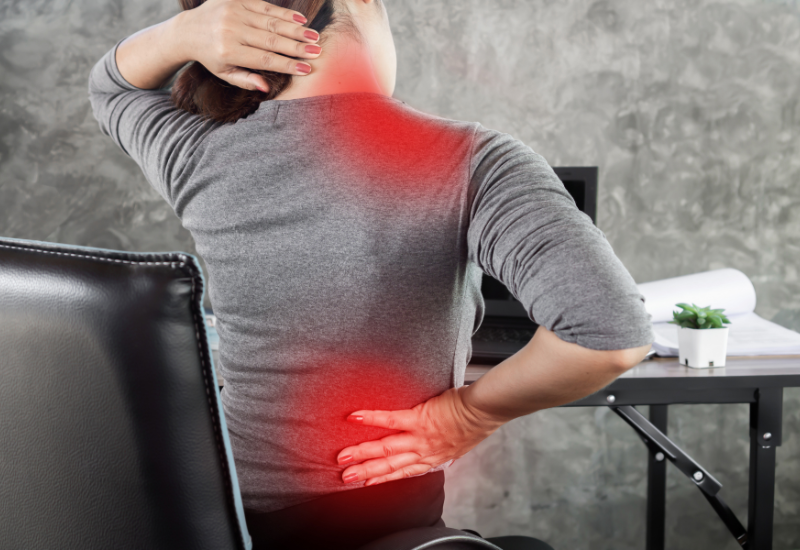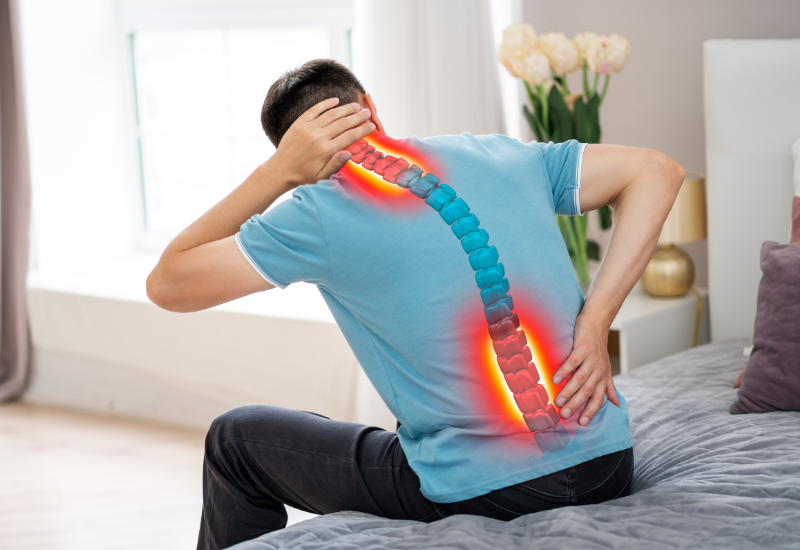Neck and Back Pain

Our Services
Let's Get In Touch

Understanding Neck Pain and Backache
Neck pain and backache are common issues that affect people of all ages and lifestyles. While they can be caused by a variety of factors, understanding the underlying causes, symptoms, and treatments can help individuals manage their discomfort effectively.
What is Neck Pain?
Neck pain refers to discomfort or pain in the neck area, which includes the cervical spine, muscles, and nerves. It can range from a dull ache to sharp pain and may be accompanied by stiffness, headaches, or even radiating pain to the arms or shoulders.
Common Causes of Neck Pain:
- Poor Posture: Slouching or hunching over computers or phones can strain neck muscles.
- Injuries: Whiplash from car accidents or sports injuries can lead to neck pain.
- Muscle Strain: Overexertion during physical activities or sleeping in an awkward position can cause muscle strain.
- Degenerative Disc Disease: Age-related wear and tear on the spinal discs can lead to pain.
- Nerve Compression: Herniated discs or bone spurs can press on nerves, causing pain that radiates into the arms
What is Backache?
Backache, or back pain, affects the lower, middle, or upper back. It can be acute (short-term) or chronic (long-lasting) and may vary in intensity. Back pain can limit mobility and interfere with daily activities.
Common Causes of Back Pain:
- Muscle or Ligament Strain: Heavy lifting, sudden awkward movements, or repetitive motions can strain back muscles.
- Herniated Discs: Discs that bulge or rupture can press on nerves, causing pain.
- Arthritis: Conditions like osteoarthritis can affect the spine and lead to back pain.
- Skeletal Irregularities: Conditions such as scoliosis (curvature of the spine) can cause pain.
- Lifestyle Factors: Being overweight, sedentary, or smoking can increase the risk of back pain.
Symptoms of Neck Pain and Backache
- Neck Pain Symptoms: Stiffness, reduced range of motion, headaches, radiating pain into arms, tingling, or numbness.
- Backache Symptoms: Sharp or dull pain, stiffness, limited mobility, radiating pain down the legs, and muscle spasms.
When to See a Doctor
Most neck and back pain is mild and can be managed at home. However, consult a healthcare provider if you experience:
- Continuous pain that doesn’t improve with rest.
- Pain following an injury or accident.
- Numbness, tingling, or weakness in the arms or legs.
- Unexplained weight loss or fever.
Chronic pain lasting more than a few weeks.
Treatment Options
- Rest and Activity Modification: Taking breaks from activities that aggravate pain can help.
- Physical Therapy: A physical therapist can provide exercises to strengthen muscles and improve flexibility.
- Medications: Over-the-counter pain relievers, such as ibuprofen or acetaminophen, can alleviate discomfort.
- Heat and Cold Therapy: Applying heat pads or ice packs can reduce inflammation and relieve pain.
- Alternative Therapies: Acupuncture, massage, and yoga can also be beneficial.
Preventive Measures
- Maintain Good Posture: Sit and stand up straight to reduce strain on the neck and back.
- Ergonomic Workspaces: Use chairs and desks that promote proper alignment.
- Exercise Regularly: Strengthening core muscles can provide better support for the back.
- Stay Active: Regular movement helps keep the spine flexible and healthy.
- Watch Your Weight: Maintaining a healthy weight can reduce strain on the back.
Conclusion
Neck pain and backache are common issues that can significantly impact daily life. Understanding the causes, symptoms, and treatment options is essential for effective management. With proper care and preventive measures, individuals can reduce their risk and enhance their quality of life.
For More Information, Read Our Blogs.
FAQ's
Poor posture and muscle strain are among the most common causes of neck pain.
Yes, stress can lead to muscle tension in the neck, contributing to pain and discomfort.
Acute back pain typically lasts a few days to a few weeks, while chronic pain persists for three months or longer.
Seek medical advice if you experience severe pain, numbness, weakness, or pain after an injury.
Gentle stretching, neck rotations, and shoulder shrugs can help relieve neck pain.
Ice is generally recommended for acute injuries to reduce inflammation, while heat can help relax tight muscles.
Yes, sleeping in awkward positions can strain the neck and back, so it’s important to maintain a neutral spine alignment.
Regular exercise, maintaining a healthy weight, and using ergonomic furniture can help prevent pain.
Yes, physical therapy can provide targeted exercises to strengthen muscles and improve flexibility.
Avoid heavy lifting, repetitive twisting motions, and activities that cause pain or discomfort.
Yes, anxiety can lead to muscle tension, which may result in neck pain.
Surgery is typically a last resort, considered when conservative treatments fail, and there is significant nerve compression or structural issues.
Be mindful of your sitting and standing positions, use supportive furniture, and take breaks to stretch regularly.
Many people find relief from alternative therapies such as acupuncture, chiropractic care, and massage.

